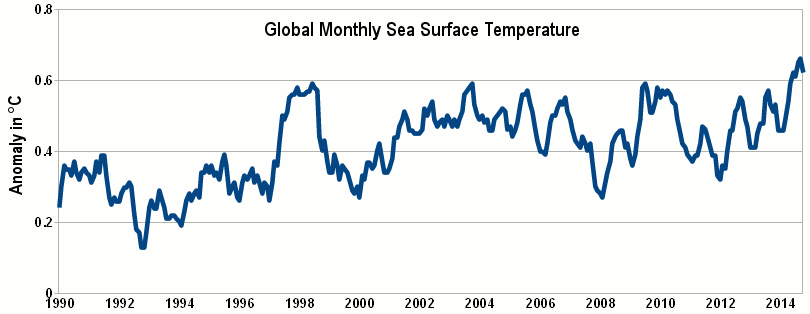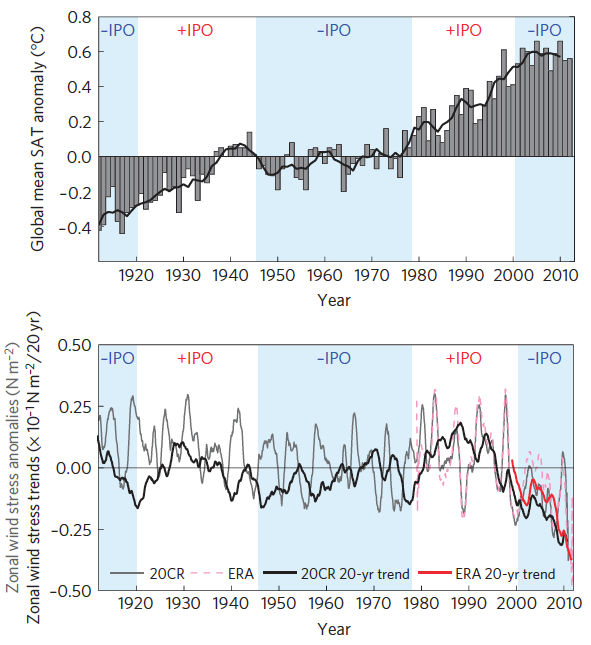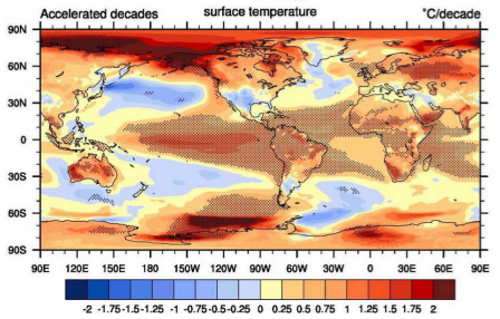
The record for the warmest monthly global sea surface temperature (SST) has been broken three times this year and the five warmest months of sea surface temperature ever recorded have all taken place in 2014. Although the year is not yet over, 2014 looks set to break the annual SST record too. This record warming of the ocean surface has, not surprisingly, had a big impact on global surface temperatures as well with 2014 currently on track to beat 2010 as the warmest year recorded in several data sets.

Figure 1. Monthly global sea surface temperature (SST) anomaly (ERSST v3b) from 1990-October 2014. June through to October 2014 has seen the 5 warmest months of SST ever recorded. Image based on data from NOAA's National Climatic Data Center.
None of this will come as a shock to regular readers of Skeptical Science as we have pointed out in numerous posts over the years that global warming has actually sped up in recent times, with an increase of heat being absorbed into the subsurface ocean despite a slower (short-term) rate of surface warming. A prime (but not only) culprit in the slower rate of global surface warming in the last decade and a half has been the temporarily strengthened wind-driven ocean circulation and, at some point, this was likely to weaken. In short; during the negative phase of the Interdecadal Pacific Oscillation (IPO) stronger winds mix more heat into the oceans, which leads to below average surface temperatures, whereas the positive phase of the IPO sees weaker winds which result in reduced ocean heat mixing and thus above average surface temperatures.

Figure 2 - The HADGEM2 climate model's average negative IPO phase (left) compared with the observed sea surface temperature (Hadley) from 2002-2011 (a negative IPO phase) on right. One dominant feature in the model simulations is the strong surface warming in the ocean gyres as convergence of warm water from the tropics there strengthens when the gyres spin-up (yellow-shaded ellipses). The intensification of the gyre circulation is apparent in the observations too. Image from the UK Met Office.
Research into multi-decadal climate variation in the Pacific Ocean stretches back decades. This field of research attracted public attention when Meehl et al (2011) examined simulations from one climate model and found that decadal hiatus periods (decades of surface cooling) were possible even when the Earth was under a strong long-term warming trend. The authors noted that the patterns exhibited in the climate model were similar to the spatial patterns of the Interdecadal Pacific Oscillation (IPO) and that, in the model at least, the negative IPO-like condition was a time when anomalous heat was taken up by the deep ocean. The year after Meehl et al, Levitus et al (2012) was published and found that not only was the subsurface ocean warming strongly but, in the recent decade, the deep ocean was warming at a greater rate than the upper ocean layers, therefore confirming the model 'prediction' in Meehl et al.
Since 2011 a slew of research papers have been published building upon Meehl et al's work. For instance, Kosaka & Xie (2013) demonstrated that when sea surface temperatures in a small, but key, part of the tropical Pacific Ocean were prescribed in climate models, the models closely matched the observed evolution of surface temperatures for the entire world - suggesting the models were doing a good job of simulating the Earth's wind-driven ocean circulation. England et al (2014) took this a step further, but rather than stipulating sea surface temperatures in a key region, the authors instead fed the model the observed changes in wind forcing. Again the model simulated the evolution in global surface temperatures with good fidelity and, more importantly, matched not only surface spatial patterns, but structural changes in the subsurface ocean too.
Another study, Risby et al (2014), revealed climate model simulations that, by chance, coincided with the timing of real world variations in the IPO, did well in matching the observed surface temperatures. And lastly, Maher (2014) extended the work of Meehl et al (2013). These authors used no less than 31 different climate models and found that anomalous surface cooling associated with the negative IPO phase was a feature common to all climate models.

Figure 3 - Global mean surface temperature trend and positive/negative IPO phases in top panel, and zonal wind stress anomalies in bottom panel. The wind strength trend anomaly since the late 2000's is unprecedented in the observational record. Image from England et al (2014).
It's possible, likely even, that some of these simulations may be over-egging the pudding somewhat because natural variability of the IPO is not the only factor to have affected surface temperatures in the last decade and a half. Volcanic aerosols, the solar cycle, and even industrial sulfate pollution may have helped to slow surface warming (see Schmidt et al [2014] and Huber & Knutti [2014]). These 'wrinkles' will be ironed out in the scientific literature in due course, but the point is that this natural oscillation in the IPO has been a major contributor to the slower rate of surface warming in recent times and in the future, when it does switch phase, surface temperatures are likely to rise more rapidly.
So does the rapid rise in global sea surface temperature in 2014 necessarily mean that the IPO has switched phase? No, not by itself, because this could be a temporary phenomenon. But there are a number of other indicators, such as local changes in sea surface height, that suggest that the background climate state has once again shifted and we might expect to see decades of accelerated surface warming. The IPO is simply an index based upon spatial patterns of SST in the Pacific Ocean, but the index is highly informative of the underlying physical behaviour of the climate system worldwide. In upcoming posts we'll look at the fundamentals of the IPO, and why we might be headed for a decade or more of accelerated surface warming.

Figure 4 - The average spatial pattern of modelled surface temperatures in accelerated warming decades from Meehl et al (2013). A distinguishing feature is the surface cooling in the subtropical ocean gyres, and the North Atlantic subpolar gyre (south of Greenland), as they spin-down in response to the weaker wind forcing. The 'cool tongue' in the eastern tropical Pacific (see Figure 2) becomes a 'warm tongue' as the trade winds weaken and upwelling of cold water from below the thermocline diminishes.
Posted by Rob Painting on Monday, 22 December, 2014
 |
The Skeptical Science website by Skeptical Science is licensed under a Creative Commons Attribution 3.0 Unported License. |